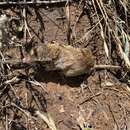en
names in breadcrumbs


Only as late as 1983 were these mice classified under the genus Chaetodipus. Previously they were part of the genus Perognathus. However, taxonomic research has supported the grouping that all spiny-rumped mice, including the Hispid pocket mouse, fall into a new genus named Chaetodipus (Caire, et al 1989).
Perception Channels: tactile ; chemical
C. hispidus are abundant in the wild. They seem to have built-in mechanism to control the population, since it has been found that there are periodic fluctuations. This can probably be attributed to the variables that surround the litter size (Stangl, et al 1995). They are preyed upon by a wide variety of predators, such as coyotes, skunks, snakes, hawks, and owls, but seem to maintain a healthy levels of their population (Chaetodipus hispidus 1999).
US Federal List: no special status
IUCN Red List of Threatened Species: least concern
While they do perform good works, C. hispidus is greatly disliked in the farming industry because they carry away the produce the farmers have worked hard to grow. As seed eaters, the mice also dig up the seeds of cantaloupe, peas, watermelon, squash, and other small grains that have been already been planted (Davis and Schmidly 1994).
Ranchers are protective of C. hispidus because they eat the seeds of weeds. This is beneficial because harmful weeds no longer spring up to pose danger to the livestock. These little pocket mice perform a great service for ranchers (Davis and Schmidly 1994).
C. hispidus are generally seed eaters, but have been known to consume insects. Their diet include seeds of cactus, evening primrose, and winecup, while the insects are usually grasshoppers, caterpillars, and beetles (Caire, et al 1989).
In the United States, the range of these creatures extends from the western Great Plains to the eastern Rockies and southeastern Arizona, and from northern Mexico to North Dakota (Chaetodipus hispidus 1999).
Biogeographic Regions: nearctic (Native )
Sandy soil scattered with some vegetation is usually the ideal environment for these pocket mice. They are most common in shortgrass priaries, grasslands, or near the growth by fence rows. The best explanation for their choice of habitat is probably the way they make their homes. They dig burrows into the soil, starting with a hole an inch in diameter straight into the ground. C. hispidus create many openings to their burrow, but usually end up piling all the dirt near one opening to camouflage the others. They usually plug these openings during the daytime. These burrows serve as food storage and nesting sites, as well (Davis and Schmidly 1994).
Terrestrial Biomes: savanna or grassland
Chaetodipus hispidus are fairly large mice in comparison to other pocket mice. They have heavier hindlimbs compared to their forelimbs. The soles of their hind feet are hairless. These mice have tails less than half the total length of their body with little or no hair on the tail (Chaetodipus hispidus 1999). Another unique feature that many of the mice in this species has is tail-tip albinism. The cause for this phenomenon is not completely understood, but it is another feature that sets apart this species (Stangl, et al 1995). They show definite bicoloration; the belly has light coloring, and the back has olive buff hairs. The average external measurements for a Texan specimen is body length of 198 mm, tail length of 93 mm, and ear length of 10 mm (Davis and Schmidly 1994).
Range mass: 30 to 47 g.
Other Physical Features: endothermic ; bilateral symmetry
Their nests are usually composed of dry grass and weeds. While the breeding season peaks from May to June, some of the far south Texas specimens may mate all year long. The average litter size is about 6 young, but the precise number is variable with climate, location, and availability of resources (Wild Animals of North America 1995). Very little is known about the gestation period or growth and development periods of the young.
Key Reproductive Features: gonochoric/gonochoristic/dioecious (sexes separate); sexual
The hispid pocket mouse (Chaetodipus hispidus) is a large pocket mouse native to the Great Plains region of North America. It is a member of the genus Chaetodipus.
The hispid pocket mouse occurs across the Great Plains from southern North Dakota to central Mexico, and west from the Missouri River to the foot of the Rocky Mountains. It is not found in far-eastern portions of the states Kansas or Missouri.
This mouse is one of the largest pocket mice. Its pelage is bristley (hispidus means "bristley"), yellowish with black hairs interspersed above. It has a distinct, buffy lateral line and white underparts.
There are four recognized subspecies:
Hispid pocket mice inhabit a variety of upland habitats, but are most abundant in areas with sandy soils and patches of bare ground. They are also found in areas with rocky, loamy soils. Hispid pocket mice are not found in rocky prairie, and seem to avoid sand dunes and riparian zones. These mice prefer a vegetation mix of short- to mid-grasses, shrubs, forbs, cacti and/or yucca.
Essentially granivores, the diet of the hispid pocket mouse consists primarily of seeds it selectively gathers, though these mice do consume some insects and leaves.
Burrows are always dug in friable soil and have two to three entrances, often plugged. Unlike other pocket mice the hispid pocket mouse often leaves a conspicuous mound of earth about the burrow entrance (like the mounds of pocket gophers, but significantly smaller).
Hispid pocket mice are solitary.
Not much is known about the reproduction of this species. Adult males have been recorded with enlarged testes from March through October, and pregnant females have been trapped in July and August. The length of the breeding season suggests females can bear two or more litters a year.
The hispid pocket mouse (Chaetodipus hispidus) is a large pocket mouse native to the Great Plains region of North America. It is a member of the genus Chaetodipus.